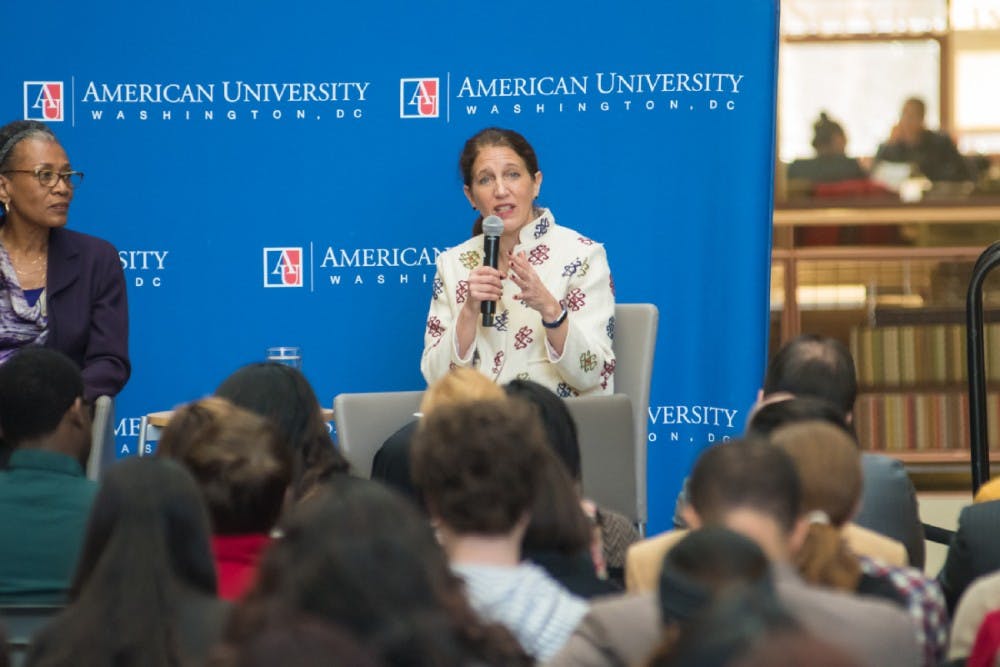As part of her release of a comprehensive diversity and inclusion strategy, University President Sylvia Burwell hosted an interactive panel Feb. 8 with Julián Castro, the former Secretary of Housing and Urban Development, and Alma Clayton-Pedersen, CEO of Emeritus Consulting Group, which assists nonprofits and other institutions with organizational development.
Burwell released AU’s Plan for Inclusive Excellence, a two-year strategy to improve diversity, equity and inclusion across campus, in late January. This panel was part of the plan’s rollout. During the panel, Burwell led a discussion on advancing diversity and inclusion in higher education, the role of leadership and ways to measure progress on the newly-released strategy.
“I’m serious about asking everyone to look at the plan and figure out where it is you can engage and be ready in June, you know, at the end of the semester, to tell us how you did it,” Burwell said.
Burwell said the University will listen to students as new programs, such as the AU Experience courses which are one year long general education courses designed for first-year students, are implemented.
“We have increased the compositional diversity of this university,” Burwell said. “But, clearly our inclusion and the cultural issues haven’t caught up.”
African-Americans have made up less than 8 percent of the undergraduate student population since 2005, according to Academic Data Reference Book published by the University annually. That percentage has not increased dramatically in recent years. For example, African-American students made up 4 percent of undergraduate students in fall 2010. In fall 2017, 7 percent of undergraduates enrolled at the University were African-American.
The number of Hispanic students, however, has increased. They made up 6 percent of the population in fall 2010 and 14 percent in fall 2017, according to the ADRB.
If students can take one aspect from the discussion led by Burwell, Castro said, it should be that their voice matters.
“A lot of the progress that’s been made here at American is due to the voices of students,” Castro told The Eagle in an interview. “You have a very open-minded and willing collaborator in President Burwell and the administration, so you have a fantastic opportunity to make a lot of progress over the next couple of years.”
Castro recalled leaving home for the first time, a community of that he described as nearly 85 percent Latinx, and going to Stanford alongside his twin brother, Joaquin. He took comfort in noticing that people at Stanford respected everyone who was there to learn, which has made him passionate about diversity and inclusion.
“I know how important it is based on my own experience in college that everybody, no matter what their background is, be able to feel comfortable on campus, in order to excel and thrive as much as possible,” Castro told The Eagle.
Clayton-Pedersen, who has worked mostly with low-income communities, said during the panel that diversity is about using what is offered in higher education. She encouraged faculty to not only review the syllabus with students on the first day of classes, but find out what the student might know about the subject, determine how best they learn and find out more about them. This will help students with different learning styles thrive in the classroom, Togrul said.
“We have to re-evaluate what is higher education generally, and we’re not having that conversation,” Clayton-Pedersen said. “We’re not having that conversation nationally at all, and that’s worrisome to me.”
Castro recalled a conversation he had with his 9-year-old daughter where she pointed out that she could not be president because “that job was for boys.”
“Right away I told her, ‘No, you can be the president, you can be a doctor, you can be an engineer, you can be anything that you wanna be,’” Castro said. “I think that we need to figure out ways from the very beginning to undo a lot of what has been done in the past in terms of expectations and roles so that we empower people.”
Burwell addressed the accountability aspect of the University’s diversity plan, which was constructed using data from the 2017 campus climate survey and Burwell’s meetings with students and other AU community members. According to the survey, 33 percent of African American students reported feeling included on campus, compared to 71 percent of white students.
“I think figuring out what we’re going to use as some of the key ways that we’ll know that we’re either making progress or we’re not is extremely important,” Burwell said.
When asked by a student in the audience about the timeline of the plan’s implementation and whether current students would see any of the changes, Burwell said diversity in education and learning would be the earliest changes students could expect to see. While 44 percent of incoming fall 2017 faculty reported themselves as people of color, the University acknowledged in the Plan for Inclusive Excellence that more faculty diversity is needed.
“I don’t know that we’ll move the cultural numbers in that short period of time,” Burwell said. “I would love it, but I’m also realistic about ‘this is hard work.’”
Burwell pointed out the changes that have already been implemented, including a bias reporting system in which students can report an incident -- such as a hate crime or discrimination based on their identity -- through an online form. The University will be transparent in keeping students up to date on the progress and effectiveness of the plan, Burwell said.
“This is a journey, it is a two-year plan,” Burwell said.





